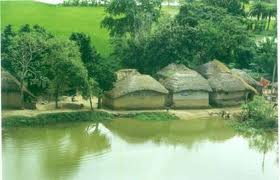The economic development of a country depends on the collective labour of different social groups. This is the reason that the system of the division of labour gradually evolves out of the practice of domestic economy. The value of the labour of all groups, including industrial labourers, peasants, carpenters, blacksmiths, goldsmiths, potters, physicians and clerks, is equal …
Category Archives: Development
Contai Basin Planning
(June 1988, Calcutta) – The Contai Basin is the area between the Rasulpor and Suvarnareka Rivers where they are about to merge in the Bay of Bengal. The Bengali name of Contai is Kán’thi derived from the Sanskrit word kan’thiká. The British changed Kán’thi to Contai because to them Kánthi sounded similar to Kandi in Murshidabad …
PROUT and Permaculture
By Ravi Logan
 Like permaculture, PROUT is a solution-oriented approach to creating sustainability by applying design principles that model the way nature works. The difference between the two approaches is in the realm of application of their respective sets of design principles.
Like permaculture, PROUT is a solution-oriented approach to creating sustainability by applying design principles that model the way nature works. The difference between the two approaches is in the realm of application of their respective sets of design principles.
Permaculture design principles were developed as a method to guide sustainable resource management (though much has been done …
Some Developmental Programmes for Bengal
(10 February 1989, Calcutta) – Much can be done to develop the socio-economic potential of Bengal, but to do this you will have to know a great deal about the local area and put this knowledge to practical use. What are the main production towns in Bengal? What are the major cities – that is, which are …
Northeastern India
(20 April 1989, Kolkata) – The northeastern region of India comprises Assam, Arunachala, Mizoram, Meghalay, Manipur and Nagaland. To the noith of India are the small states of Nepal, Bhutan and Sikkim.
The shape of Nepal is like a rectangle – the length from east to west is greater than the width from north to south. Nepal is
PROUT Lessons from Development Work in West Africa
In June 2000 I arrived in West Africa to coordinate AMURT development projects. These last twelve years have been an incredible adventure for me, giving me the special privilege to work closely with the people in villages in Ghana, Burkina Faso and Nigeria. I am very grateful for having had this opportunity to expand my mind and …
Master Units
By P.R. Sarkar
(10 November 1989, Kolkata) – In the beginning, Master Units were started with a view to developing the fate of the backward and downtrodden classes of society who find no scope to keep pace with the developing world. When Ananda Marga started touching every discipline of life, it was then contemplated to establish the Master Units as …
Developmental Programs
P.R. Sarkar
 (17 April 1988, Calcutta) – In ancient times bullion was used as the medium of political and commercial transactions. In most countries gold was the preferred bullion, but in some countries silver bullion was also used. Of the countries which used gold bullion, some recognized silver bullion and some did not. If a country which used gold bullion …
(17 April 1988, Calcutta) – In ancient times bullion was used as the medium of political and commercial transactions. In most countries gold was the preferred bullion, but in some countries silver bullion was also used. Of the countries which used gold bullion, some recognized silver bullion and some did not. If a country which used gold bullion …
Multi-Purpose Development Schemes
P.R. Sarkar
(1989) – The forward march of human beings requires an internal approach and an adjustment with external objectivities. That is, it requires an internal, spiritual approach, as well as an external approach which maintains balance, equilibrium and equipoise in the different arenas of our social, economic and cultural life.
Humanity is presently suffering from two problems — one …
Strategies to Eradicate Poverty: An Integral Approach To Development – I
Roar Bjonnes
1. Introduction
Poverty has many causes and expressions– including political, environmental, educational, cultural, and spiritual–economic reform is therefore not a panacea. To eradicate poverty, we must instead develop a multidimensional set of remedies. Most importantly, we must realize that economic growth is not an end in itself, it is simply the means by which civilization can advance and …






